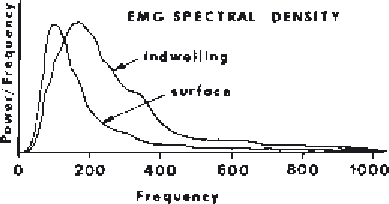Biomedical Engineering Reference
In-Depth Information
Figure 10.7
Frequency spectrum of EMG as recorded via surface and indwelling
electrodes. The higher-frequency content of indwelling electodes is the result of the
closer spacing between electrodes and their closer proximity to the active muscle fibers.
true undistorted sound at the loudspeakers. Similarly, the EMG should have
all its frequencies amplified equally. The spectrum of the EMG has been
widely reported in the literature, with a range from 5 Hz at the low end to
2000 Hz at the upper end. For surface electrodes, the m.u.a.p.'s are longer in
duration and, thus, have negligible power beyond 1000 Hz. A recommended
range for surface EMG is 10 - 1000 Hz, and 20 - 2000 Hz for indwelling elec-
trodes. If computer pattern recognition of individual m.u.a.p.'s is being done,
the upper cutoff frequencies should be increased to 5 and 10 kHz, respec-
tively. Figure 10.7 shows a typical EMG spectrum, and it can be seen that
most of the signal is concentrated in the band between 20 and 200 Hz, with
a lesser component extending up to 1000 Hz.
The spectra of other physiological and noise signals must also be consid-
ered. ECG signals contain power out to 100 Hz, so it may not be possible
to eliminate such interference, especially when monitoring muscle activity
around the thoracic region. The major interference comes from power line
hum: in North America it is 60 Hz, in Europe 50 Hz. Unfortunately, hum lies
right in the middle of the EMG spectrum, so nothing can be done to filter it
out. Movement artifacts, fortunately, lie in the 0 - 10 Hz range and normally
should not cause problems. Unfortunately some of the lower-quality cabling
systems can generate large low-frequency artifacts that can seriously inter-
fere with the baseline of the EMG recording. Usually such artifacts can be
eliminated by good low-frequency filtering, by setting
f
1
to about 20 Hz. If
this fails, the only solution is to replace the cabling or go to the expense of
using microamplifiers right at the skin surface.
It is valuable to see the EMG signal as it is filtered using a wide range of
bandwidths. Figure 10.8 shows the results of such filtering and the obvious
distortion of the signal when
f
1
and
f
2
are not set properly.
10.2.4 Common-Mode Rejection
The human body is a good conductor and, therefore, will act as an antenna
to pick up any electromagnetic radiation that is present. The most common










Search WWH ::

Custom Search